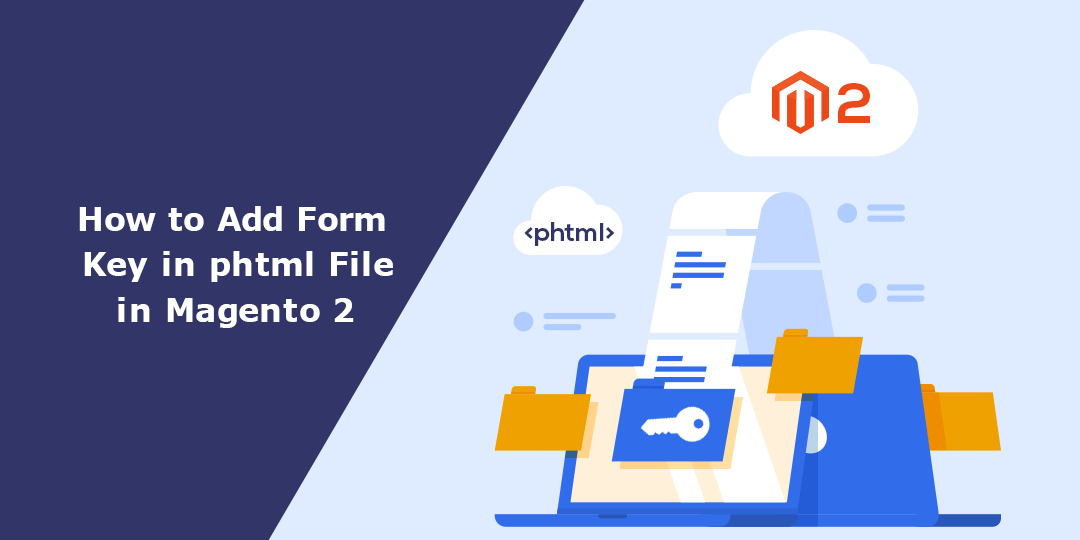Hello Magento Friends,
In this blog, we will learn How to Add Form Key in phtml File in Magento 2.
Form key helps to prevent Cross-Site Request Forgery attack. This means an attacker encourages users to perform actions they don’t intend to. Using the form key in Magento 2, you can keep your site safe from CSRF (Cross-Site Request Forgery) attacks.
Let’s learn how to add a form key in Magento 2.
Steps to Add Form Key in phtml File in Magento 2:
Step 1: Create block file Index.php in the given path
app/code/Vendor/Extension/Block/Index/Index.php
Now add the code as given below
<?php
namespace Vendor\Extension\Block\Index;
use Magento\Framework\Data\Form\FormKey;
class Index extends \Magento\Framework\View\Element\Template
{
public function __construct(\Magento\Catalog\Block\Product\Context $context, FormKey $formKey,array $data = [])
{
$this->formKey = $formKey;
parent::__construct($context, $data);
}
protected function _prepareLayout()
{
return parent::_prepareLayout();
}
public function getFormKey()
{
return $this->formKey->getFormKey();
}
}Step 2: Create layout file customer_index_index.xml at the below path
app/code/Vendor/Extension/view/frontend/layout/ customer_index_index.xml
And embed the below code
<?xml version="1.0"?>
<page xmlns:xsi="http://www.w3.org/2001/XMLSchema-instance" xsi:noNamespaceSchemaLocation="urn:magento:framework:View/Layout/etc/page_configuration.xsd">
<head>
<title>Customer Contact Form</title>
</head>
<body>
<referenceContainer name="content">
<block class="Vendor\Extension\Block\Index\Index" template="Vendor_Extension::customer.phtml"/>
</referenceContainer>
</body>
</page>Step 3: Create a customer.phtml file at the following path
app/code/Vendor/Extension/view/frontend/templates/customer.phtml
Now add the below-mentioned code
<!-- here use your controller path in form action -->
<form enctype="multipart/form-data" action="<?php echo $block->getBaseUrl().'customer/index/post/';?>" name="customemaildata" method="post" id="contactForm-1" data-hasrequired="<?php echo __('* Required Fields') ?>" data-mage-init='{"validation":{}}'>
<fieldset class="fieldset">
<input name="form_key" type="hidden" value="<?php echo $block->getFormKey();?>">
<div class="field email required">
<label class="label" for="email">Name :-</label>
<div class="control">
<input name="name" id="name" class="input-text" type="text" data-validate="{required:true}"/>
</div>
</div>
<div class="field email required">
<label class="label" for="email">Email:-</label>
<div class="control">
<input name="email" id="email" class="input-text" type="email" data-validate="{required:true, 'validate-email':true}"/>
</div>
</div>
</fieldset>
<div class="actions-toolbar">
<div class="primary">
<input type="hidden" name="hideit" id="hideit" value="" />
<button type="submit" title="<?php echo __('Submit') ?>" class="action submit primary">
<span><?php echo __('Submit') ?></span>
</button>
</div>
</div>
</form>The input tag will return with the form as given below. You can use this key based on your requirement.
<input name="form_key" type="hidden" value="u4b7uLozXoFaA6br">
Conclusion:
Using the above steps, you can easily add form key in phtml file in Magento 2. To add advanced security to your Magento 2 store, avail of Magento Security Patches Installation Service and safeguard your store from vulnerabilities.
Share the article with other Magento merchants, and stay with us!
Happy Coding!








